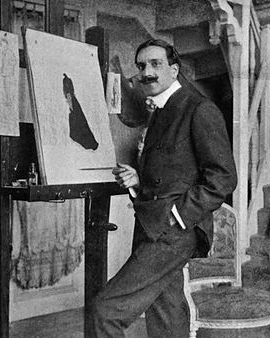


Leonetto Cappiello is considered the father of modern posters and billboards. During his lifetime, the Italian artist produced more than 530 posters, which came in bright colors. He also worked as an illustrator and caricaturist. Cappiello lived in Paris, where he created caricatures with a satirical and humorous touch for the magazine Le Rire and other magazines. In 1899, the poster artist first attracted attention in La Revue blanche, a literary and artistic magazine for which his contemporary Henri de Toulouse-Lautrec also produced works.
Cappiello began producing his posters around 1900; he had them printed mainly by the publisher P. Vercasson. In 1921, he changed the centre of his life after signing a contract with the Maison Devambez art printing house in Cappiello is still considered the father of modern advertising today, because all his posters had advertising character. Unlike other poster artists of his time, he used dark backgrounds, from which the colourful figures stood out particularly well and literally jumped into the viewer's face. The Livorno-born illustrator had no formal art training whatsoever. As early as 1892 his first works were exhibited in a museum in Florence. He also published several volumes of caricatures at the beginning of his career. His real breakthrough, however, came with his posters, whose striking style differed significantly from that of his contemporaries. Because of their colourfulness and lack of frills, these posters had an extremely modern appearance and revolutionised poster art.
After the First World War ended, Cappiello continued to produce posters. From then on, he worked for the Parisian agency Devambez, for which he created some of his most iconic works. The artist worked for the advertising agency until 1936, producing posters for renowned brands such as Campari and Pirelli and for personalities such as Mistinguett.
To this day, the advertising posters of the Italian-born artist are considered groundbreaking and worth collecting. Their blunt and clear style is considered to be groundbreaking for the entire poster art of the time and has been adopted by other artists and contemporaries since the turn of the century. In contrast to poster painters such as Henri de Toulouse-Lautrec, Alphonse Mucha and Gustav Klimt, Cappiello deliberately dispenses with ornate and decorative elements in order to place the product or the advertised person at the centre of the overall composition.

Leonetto Cappiello is considered the father of modern posters and billboards. During his lifetime, the Italian artist produced more than 530 posters, which came in bright colors. He also worked as an illustrator and caricaturist. Cappiello lived in Paris, where he created caricatures with a satirical and humorous touch for the magazine Le Rire and other magazines. In 1899, the poster artist first attracted attention in La Revue blanche, a literary and artistic magazine for which his contemporary Henri de Toulouse-Lautrec also produced works.
Cappiello began producing his posters around 1900; he had them printed mainly by the publisher P. Vercasson. In 1921, he changed the centre of his life after signing a contract with the Maison Devambez art printing house in Cappiello is still considered the father of modern advertising today, because all his posters had advertising character. Unlike other poster artists of his time, he used dark backgrounds, from which the colourful figures stood out particularly well and literally jumped into the viewer's face. The Livorno-born illustrator had no formal art training whatsoever. As early as 1892 his first works were exhibited in a museum in Florence. He also published several volumes of caricatures at the beginning of his career. His real breakthrough, however, came with his posters, whose striking style differed significantly from that of his contemporaries. Because of their colourfulness and lack of frills, these posters had an extremely modern appearance and revolutionised poster art.
After the First World War ended, Cappiello continued to produce posters. From then on, he worked for the Parisian agency Devambez, for which he created some of his most iconic works. The artist worked for the advertising agency until 1936, producing posters for renowned brands such as Campari and Pirelli and for personalities such as Mistinguett.
To this day, the advertising posters of the Italian-born artist are considered groundbreaking and worth collecting. Their blunt and clear style is considered to be groundbreaking for the entire poster art of the time and has been adopted by other artists and contemporaries since the turn of the century. In contrast to poster painters such as Henri de Toulouse-Lautrec, Alphonse Mucha and Gustav Klimt, Cappiello deliberately dispenses with ornate and decorative elements in order to place the product or the advertised person at the centre of the overall composition.
Page 1 / 3






